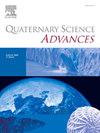Surface ruptures from the 1556 Huaxian earthquake, North China, measured using high-resolution topography: Implications for large magnitude normal-faulting earthquakes in continental interiors
IF 2.2
Q2 GEOGRAPHY, PHYSICAL
引用次数: 0
Abstract
On January 23, 1556, a large normal-faulting earthquake struck Huaxian county, in the eastern part of the Weihe Graben, North China. The direct effects of the great shock and the following famine, exposure to coldness, and disease together killed more than 830,000 people, making the Huaxian earthquake the deadliest in history. Estimates of its magnitude vary widely, with intensity data leading to estimates of 8¼ to 8½, whereas geological estimates of slip and fault length suggest a range of 7.5–8.0, but with remaining uncertainty due to the lack of detailed measurements along the entire rupture zone. In this study, we use high-resolution digital elevation models (DEMs) derived from Pléiades stereo satellite imagery to map the surface ruptures and measure the fault scarps associated with the 1556 earthquake. We use the vertical offset measurements and the cumulative offset probability density (COPD) method to constrain the surface slip distribution of the 1556 event and to examine evidence for prior rupture. We find an average vertical displacement of 6.3 ± 0.7 m, consistent with a moment-magnitude (Mw) of 7.3–7.9 that, although large, is much smaller than earlier estimates derived from seismic intensity data. Although the Huaxian earthquake is likely the largest known well-defined normal-faulting event in history, it aligns with the global pattern that normal-faulting earthquakes in continental interiors rarely exceed Mw 8. We suggest that the magnitudes of other large historical earthquakes in North China need to be reexamined by direct fault parameters, rather than by shaking intensity and death toll.
1556年华北华县地震的地表破裂,用高分辨率地形测量:大陆内部大震级正断层地震的意义
1556年1月23日,华北渭河地堑东部华县发生正断层大地震。大地震的直接影响以及随之而来的饥荒、严寒和疾病共造成83万多人死亡,使华县地震成为历史上死亡人数最多的地震。对其震级的估计差异很大,强度数据估计为8¼至8½,而对滑动和断层长度的地质估计为7.5-8.0,但由于缺乏沿整个断裂带的详细测量,仍然存在不确定性。在这项研究中,我们使用来自pl宇航立体卫星图像的高分辨率数字高程模型(dem)来绘制地表破裂图,并测量与1556年地震相关的断层陡坡。我们使用垂直偏移测量和累积偏移概率密度(COPD)方法来约束1556事件的地表滑动分布,并检查先前破裂的证据。我们发现平均垂直位移为6.3±0.7 m,与7.3-7.9级的矩震级(Mw)一致,虽然很大,但比早先从地震强度数据中得出的估计要小得多。尽管华县地震可能是历史上已知的最大的正常断层活动,但它与全球模式一致,即大陆内部的正常断层地震很少超过8级。我们建议,华北其他历史大地震的震级需要通过直接断层参数来重新检查,而不是通过震动强度和死亡人数。
本文章由计算机程序翻译,如有差异,请以英文原文为准。
求助全文
约1分钟内获得全文
求助全文
来源期刊

Quaternary Science Advances
Earth and Planetary Sciences-Earth-Surface Processes
CiteScore
4.00
自引率
13.30%
发文量
16
审稿时长
61 days
 求助内容:
求助内容: 应助结果提醒方式:
应助结果提醒方式:


